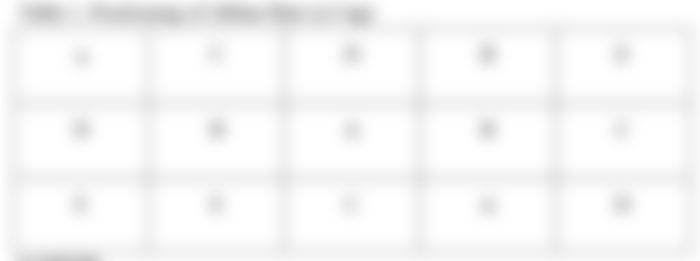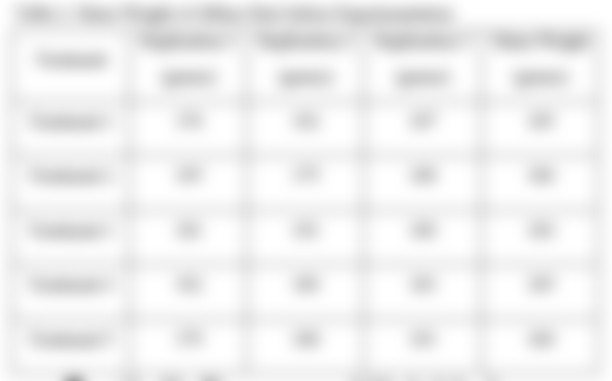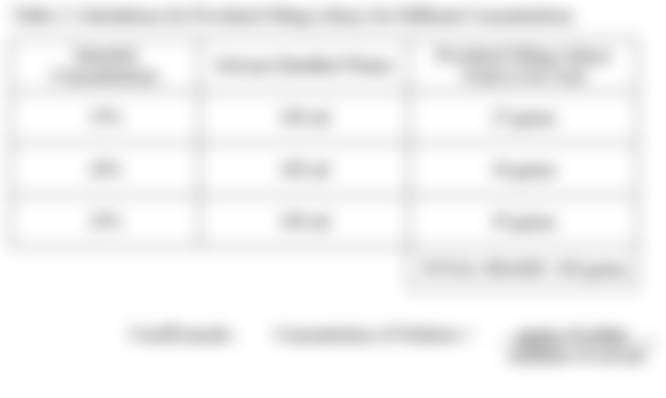METHODOLOGY
This chapter presents the method employed by the researchers in the conduct of this study. The research design was explained together with the materials used, procedures, experimental design, data gathering and the data analysis method.
I. Research Design
The proponents engaged experimental research design to come up with the objectives. This research design was used because it is best suited for this study. This research design allowed the researchers to determine the cause-effect relationship between the produced antiseptic spray from fruits of siling labuyo (Capsicum frutescens) and the wounds of albino rats. It also allows the control of variable. Among the group of variables, the amount of the powdered siling labuyo fruits were manipulated to determine the effectiveness by applying in the wounds of albino rats.
To be more specific, the study engaged pre-test/post-test control group design where there are two groups which are control group and experimental group. Control group are those respondents that are treated with distilled water while the experimental group are the respondents that are treated by antiseptic solutions.
II. Procedure
A. Acclimatization of animals
Experimental animals were fifteen (15) healthy young male and female albino rats, weighing between one hundred seventy-five to one hundred ninety-five grams. (175-195 g). These rats were randomly selected assigned in five (5) groups. Treatment 1 as the control group treated with distilled water and treatment 2 is treated with commercial product (betadine) while the three other treatments were treated with the decocted siling labuyo fruits with three different concentrations of fifteen percent (15%), twenty percent (20%) and twenty-five percent (25%) antiseptic spray for abrasion. It were housed in a huge standard cage for acclimatization period of seven (7) days or one (1) week before the commencement of experiment. During this period the animals had free access to standard pellet diet and water in an ambient temperature of (25±2˚C). An aspen was also changed daily or every twenty-four hours. Upon caging the albino rats, the position were randomized to lessen the factors that could affect the study. The position of the albino rats with corresponding treatment is shown below:

LEGEND:
A – albino rats treated with distilled water
B – albino rats treated with betadine
C – albino rats treated with 15% concentration of siling labuyo
D – albino rats treated with 20% concentration of siling labuyo
E – albino rats treated with 25% concentration of siling labuyo
B. Mean Weight of Albino Rats before Experimentation

The weight of the albino rats were recorded the day before the commencement of experimentation. It was recorded in the purpose of knowing if the animals were harmed or stressed due to the experiment.
B. Decoction of Siling Labuyo (Capsicum frutescens) Fruits
Upon the decoction of siling labuyo (Capsicum frutescens) fruits, a standard decoction process from (Justis, 2016) was followed.
1. Powdering the Siling Labuyo (Capsicum frutescens) Fruits
The researchers gathered fruits of siling labuyo (Capsicum frutescens) to be used in the study. Two hundred eighty grams (280g) of siling labuyo fruits were collected in the locality of Mandaon, Masbate. The proponents made sure that the gathered siling labuyo fruits were not sprayed by any insecticides that may affect the entire study. After gathering, the fruits were washed with water to make sure that there are no other substances like dust included that may affect the study. The stem-like matters or the peduncles that holds the siling labuyo fruits were also separated. Then the fruits were dried in an oven for twenty (20) minutes. The reason why the fruits were dried because according to (Justis, 2016), if fresh fruits were used, the liquid substance in the fruits will dilute the solution. Later on, the dried fruits were grinded using blender. The mass of the powdered siling labuyo was one hundred eight grams (108g).
2. Calculating the Mass of Powdered Siling Labuyo (Capsicum frutescens) Fruits to be used in the Intended Concentrations
The researchers intended to make an antiseptic spray with a concentration of 15%, 20%, and 25% of siling labuyo fruits. Upon getting the grams of powdered siling labuyo fruits to be used in the different concentrations, the proponents were guided by the formula; concentration of solution is equal to grams of the solute over millilitre of solvent (concentration of solution = grams of solute/ millilitre of solvent). The solvent used was distilled water with a constant volume of one hundred eighty millilitre (180ml) to be used equally in making three antiseptic solutions with different concentrations of siling labuyo fruits. Fifteen percent (0.15) was multiplied to one hundred eighty millilitre of distilled water (180 ml) to get the amount of powdered siling labuyo fruits for 15% concentration. The same calculation process was used to get the amount of powdered siling labuyo fruits to be used in 20% and 25% concentration. The computed amount of powdered siling labuyo fruits for 15% concentration was twenty-seven grams (27 g), for 20% concentration was thirty-six grams (36g), and for 25% concentration was forty-five grams (45g) of powdered siling labuyo fruits.

3. Making an Antiseptic Solution
The distilled water was put in a refrigerator because a cold water is required to be used in decoction process according to (Justis, 2016). Part of decoction is infusion. “An infusion is prepared by bringing the desired amount of water to a boil, pouring it to a herb, and letting it sit covered for twenty minutes” (Blankespoor, 2013). To make an antiseptic solution with a concentration of 15%, the computed mass of powdered siling labuyo fruits for 15% concentration which is 27 grams were put in a stainless steel pot and mixed with 180ml cold distilled water. It was stainless pot that was used because according to (Blankespoor, 2013), it is the advisable material to be used in the infusion. The mixture of water and powdered siling labuyo fruit was put in a gas stove and simmered for 20 minutes. Blankespoor (2013) and Justis (2016) suggests to simmer the mixture for 20 minutes that is why the proponents used 20 minutes to simmer. After twenty minutes it was filtered using coffee filter, stored in a jar and put into refrigerator to avoid contamination of bacteria. The same process were done to make an antiseptic solutions with the concentrations of 20% and 25% of siling labuyo only that the grams of powdered siling labuyo used was the computed amount intended to each concentration.
4. Packaging of Antiseptic Solution
The proponents intended to make an antiseptic spray instead of paste, cream, or ointment to have a constant amount of solution with every spray and for the wound not to be irritated. The researcher provided spray containers for three different concentrations. Before the solutions were transferred, the spray containers were sterilized to avoid the contamination of other substance. The antiseptic solutions were transferred each to the spray containers. Afterwards, the proponents designed a layout with the product name indicating the concentration of siling labuyo in each antiseptic spray and its components. The layout printed in a sticker and pasted in an antiseptic spray with a description appropriate for its concentration.
C. Experimentation or Testing of Antiseptic Solution
The researchers consulted a veterinarian to create wounds on albino rats. As to avoid infections or health complication to albino rats, the veterinarian created wounds in albino rats for veterinarians are more knowledgeable than any other person. The veterinarian made an abrasion or a scrape, to be more specific, with a measurement of two centimeters each sides or four hundred square millimetres (400 mm2). Same measurement was applied to 15 albino rats. Three replicates for each treatments that is why the researchers scoped 15 rats.
After the wounds were created the produced antiseptic spray with different concentrations were sprayed to the wounds. An amount of the chosen commercial antiseptic which is betadine was also applied by dropping an amount of it to the wounds. Albino rats in the control group were treated by spraying an amount of distilled water to the wounds. The purpose of the control group treated with distilled water is to know if the produced antiseptic sprays were effective or not by comparing its healing rate to the healing rate of produced antiseptic sprays. The researchers sprayed the treatments every 12:00pm, and 5:00pm for six days.
Every 48 hours, the researchers observed and measured the area of wounds of the albino rats. The measurements of the wounds in each replicate with corresponding antiseptic solutions were recorded in the table (Table 4). The observation was done for only six (6) days until the wounds were completely healed. The concentration that best healed the wounds with respect to time was determined then the data were compared to the data of betadine to see if there is significant difference using statistical test.
III. Experimental Design

Each treatment has three replicates for the data to be accurate. Treatment 1 is the treatment applied to control group which is the distilled water, treatment 2 is an antiseptic which is betadine. Treatment 3 is the produced antiseptic spray with a concentration of powdered siling labuyo fruits which is 15%. Treatment 4, is the produced antiseptic spray with 20% concentration of powdered siling labuyo fruits, and treatment 5 is the produced antiseptic spray with 25% concentration of powdered siling labuyo fruits. The proponents measured the area of wounds every 2 days (Forty-eight hours) by the unit of square millimeter and recorded the measurement of every wound in the table above with its corresponding treatment number & replication number.
The proponents also recorded the observation, day number, and date. The signature of the qualified professional or the veterinarian, in this study, was also included to make sure that the researchers were guided. The same form were filled up until the end of six (6) days.
IV. Materials
In the decoction of the fruits of siling labuyo (Capsicum frutescens), the following materials were used: siling labuyo fruits, blender, oven, gloves, basin, strainer, glass container, gas stove, stainless pot, weighing scale (kitchen scale), and mask. The study also used cage for albino rats, feeding through, distilled water, aspen, and beefpro feeds.
For the wound making, the following materials were used: albino rats, laboratory gown, gloves, masks, surgical blade, holding tray, clean cloth, and cotton balls.
In transferring of antiseptic solution to spray containers the materials used were gloves, masks, sterilized funnel and spray containers, distilled water, gas stove, and stainless pot. And in packaging, the material used was sticker.
V. Data Collection Method
The researchers engaged observation method as to gather data from the experiment. The antiseptic solutions were applied 2 times a day and the interval of observation is every 48 hours. The observation was done as to know if the produced antiseptic sprays were effective or not regarding on the healing period of the wounds in each albino rat applied with different concentrations of solution. The area of wounds are measured every observation and are recorded after every 48 hours. The recorded data served as the bases upon determining which of the produced antiseptic solutions can be best used for abrasion with respect to its healing time. It’s also the recorded data that served as the bases in comparing the produced antiseptic spray that best healed the abrasion to the chosen commercial antiseptic product (betadine). Upon the statistical calculations, the bases were also the recorded data.
VI. Data Analysis
The study cannot be interpreted objectively without using appropriate statistical analysis or test/calculations. The test that was used was ANOVA or the Analysis of Variance. Analysis of Variance was used because it is the appropriate test for our study. Thus, it is a test which usually used when there are two or more variables to compare. Like in the case of this study, there are five treatments which were involved to be compared therefore ANOVA was used to have the result in comparison.
To avoid misconceptions especially in the interpretation of the statistical results and as well as for the guidance, the proponents consulted a person acquiring expertise in both statistics and research.
Upon the Analysis of Variance, the gathered data from the area of wounds healed were used and not the area of wounds itself.




this was your experiment? what's the result? or I did not understand it because am looking for its efficacy